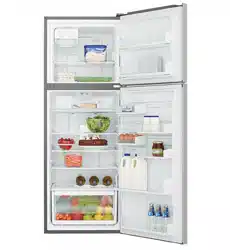Documents: Go to download!
- Owner's manual - (English)
User Manual Westinghouse WTB3400AH-X Top Mount Fridge
INSTALLATION
Clean the refrigerator thoroughly according to instructions and wipe away any dust that has accumulated during shipping.
Check that the floor is level. If it is not, adjust the stabilising foot so that the refrigerator is level and stable.
We recommend that the refrigerator be turned on and left to run for two to three hours before placing any food inside it. This will allow you to check that it is operating properly and there is adequate cool air in the freezer.
Installation clearances
- Allow a minimum of 30mm clearance on both sides of the refrigerator.
- Allow a minimum of 50mm clearance at the back of the refrigerator.
- Allow a minimum of 50mm (X) clearance above the refrigerator.
- If you do not have above cupboard with a rear gap of minimum 100mm (Y), recommended clearance at the top of the refrigerator is 90mm (X).
- When positioned in a corner, the clearance must be at least 300mm on the hinge side to allow the door to open smoothly so that bins and shelves can be removed easily. For easy removal of Crisper it is recommended to remove bottle door bin first if minimum clearance in the corner on hinge side is less than 350mm.
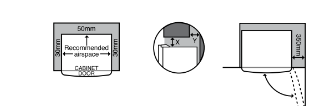
NOTE: Refrigerator doors on all models are designed to sit proud of cabinetry (not flush). In installations where both sides and the rear of the refrigerator are not enclosed by cabinetry e.g. the refrigerator is placed against a wall, the clearance between the rear of the refrigerator and the wall should not be greater than 75mm.
Initial start up
When in operation, the outside of the refrigerator will feel warm, particularly at start up. This is normal.
Avoid placing food against air outlets as this will impede air circulation.
A light frosting will occasionally occur on the cold interior of the freezer if the door is opened frequently. This is normal and the frost will disappear after a few days in most climates.
Make sure that the freezer and fresh food doors are fully closed after you have loaded or removed food from these compartments. If the doors are left partly opened, a heavy frost will coat the inside of the freezer. If this occurs, remove the frost. Ensure that all doors are properly closed to prevent frost from reappearing.
Your refrigerator uses energy efficient components that may produce different noises from your old refrigerator. Occasionally, a gurgling sound of refrigerant flowing or sound of parts expanding or contracting can be heard. These noises are quite normal.
Cleaning
Exterior
Clean the refrigerator with only lukewarm soapy water and a soft cloth. Rinse with clean water and then wipe the surface with a soft clean cloth to remove any soap residue.
Interior
Clean the refrigerator interior regularly. Turn power off. Wipe the interior with a soft cloth and lukewarm soapy water. Thoroughly dry all surfaces and removable parts. Avoid getting water on the refrigerator controls. If you have taken out any removable parts, replace them and switch on the power before re-stocking the refrigerator. Wipe away thoroughly any food spills.
Keep door seals clean
Ensure that the door seals are always clean. Sticky food and drinks can cause seals to adhere to the cabinet and may cause the seal to tear when opening the door. Wash seals with lukewarm soapy water. Rinse thoroughly and dry.
CAUTION WARNING
Never use hot water, solvents, commercial kitchen cleaners, aerosol cleaners, metal polishers, caustic or abrasive cleaners or scourers to clean the appliance as they will damage it. Many commercially available cleaning products and detergents contain solvents that will damage your refrigerator. When cleaning, use only a soft cloth and lukewarm soapy water.
TOP FREEZER FEATURES

BOTTOM FREEZER FEATURES

TEMPERATURE CONTROL
Set the temperature by using the slide temperature controls, refer to the relevant instruction for Bottom mount freezer or Top mount freezer models shown in this section. When you first turn on the refrigerator, set both the refrigerator and freezer temperature control to MID.
Bottom mount models
Bottom mount refrigerator temperature adjustment
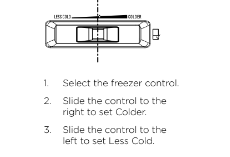
Bottom mount freezer temperature adjustment

Top mount models
Top mount refrigerator temperature adjustment

Top mount freezer temperature adjustment

FEATURES
This section tells you how to make the most of the many useful features of the refrigerator and how to clean them.You can adjust the refrigerator bins to meet different storage needs.
Door storage bins
The refrigerator has door storage bins. You can adjust the refrigerator bins to meet different storage needs. All the door bins are completely removable for cleaning. If you want to remove or adjust a bin, lift and tilt to remove. To replace, tilt the top and push bin down until the support lugs lock it in place.

Crisper bin
Storing vegetables
Use the crisper bin to store vegetables, fruits or small items. You can adjust the humidity inside the bin by sliding the humidity control.
Storing fruits and small items
You can store fruits in the crisper bin, but do remember to lower the humidity via the humidity control. The humidity can be adjusted by the sliding the lever on the humidity control.

Deodoriser
Your refrigerator is fitted with a deodoriser to assist with the removal of food odours inside your refrigerator. Keeping the food covered and wrapping it in plastic will also help to reduce the odours inside your refrigerator.
Door alarm
If the refrigerator door is left open longer than two minutes, a buzzer will sound. Re-set the alarm by pressing the light switch.
LED lighting
Your refrigerator is fitted with long life LED lighting. In the unlikely event the LED lights should ever fail, then the LED lights need to be serviced by a qualified technician. Refer to page 15 for contact details.
Bottom Mount Deodoriser

Top Mount Deodoriser
FOOD STORAGE GUIDE
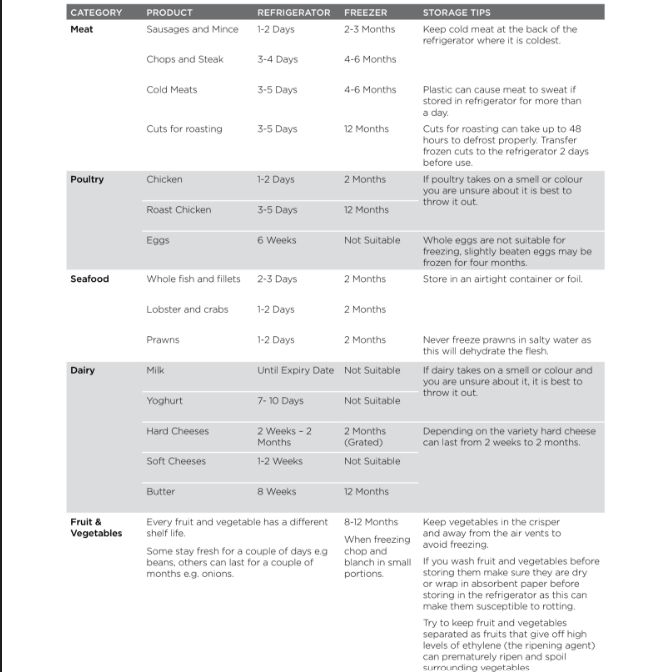
NOISES
Appliance noise
Your new refrigerator may make sounds that your old one didn’t make. Because the sounds are new to you, you might be concerned about them. Most of the new sounds are normal. Hard surfaces, like the floor, walls and cabinets, can make the sounds seem louder than they actually are. The following describes the kinds of sounds and what may be making them.”
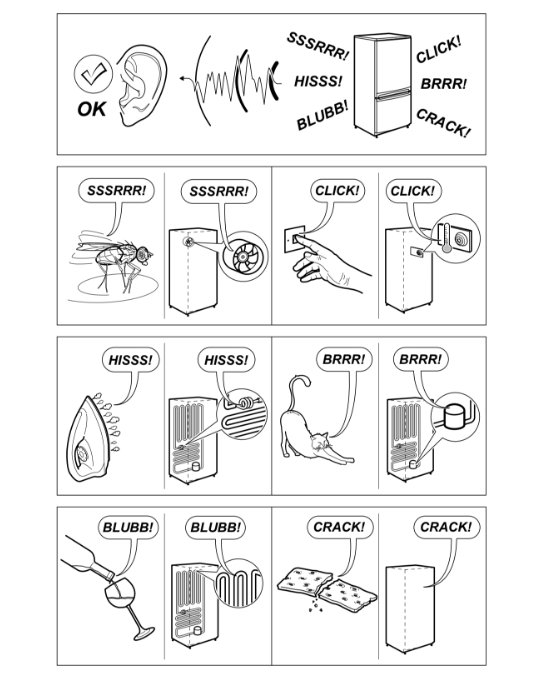
TROUBLESHOOTING
Appliance does not operate at desired temperature
In a modern frost free refrigerator / freezer, cold air is circulated around the various compartments through air vents using a high efficiency fan.
1. Refrigerator is too warm.
- Ensure food is allowed to cool before placing inside the refrigerator.
- Ensure the appliance is set up as per instructions on page 11.
- Ensure that contents are not obstructing the cooling vents.
- Ensure the door is not held open or is being opened too frequently.
2. Freezer is too warm.
- Adjust temperature to a colder setting.
- Ensure food is allowed to cool before placing inside the freezer.
- Ensure the appliance is set up as per instructions on page 11.
- Ensure that contents are not obstructing the cooling vents.
- Ensure the door is not held open or is being opened too frequently.
3. Food is freezing in the refrigerator.
- Adjust temperature to a warmer setting.
- Ensure that fruit and vegetables are stored in the crisper. Items with a high water content should not be placed near the cooling vents.
4. Unable to change temperature settings.
- Refer to function guide in Controlling Your Refrigerator.
- Ensure that user interface is in "awake" mode before trying to adjust temperature settings.
Appliance noise
Your new refrigerator may make sounds that your old one didn’t make. Because the sounds are new to you, you might be concerned about them. Most of the new sounds are normal. Hard surfaces, like the floor, walls and cabinets, can make the sounds seem louder than they actually are. The following describes the kinds of sounds and what may be making them.
1. Motor noise (compressor).
- Nothing. This is normal as your new refrigerator uses a variable speed compressor and fan that at start up and on warm days runs at a high speed to provide additional cooling.
- When less cooling is required the compressor and fan will run at a lower speed
- Note that the compressor noise may seem louder at the start of the on cycle.
2. A clicking noise heard just before the compressor starts.
- Nothing. This is normal as your new refrigerator has an automatic switching action of the temperature control, turning the compressor on and off.
3. Occcasional gurgling, similar to water boiling.
- Nothing. As each refrigeration cycle ends, you may hear a gurgling sound due to the refrigerant flowing in your refrigerator system.
4. Airflow noise.
- Nothing, this is normal as your new refrigerator uses high efficiency fans to circulate air. Fan speed and noise may increase during periods of heavy usage or hot weather.
5. Rattling and other noises.
- Ensure that the cabinet is level and stable, refer to Installation Instructions on page 11.
- Check the surrounds of the appliance to ensure there is nothing touching or placed on top of the appliance.
- Ensure that contents of the appliance are not placed in such a way that they are vibrating (such as bottles).
Refrigerator operation
1. When your appliance is not operating
- Check that the power cord is plugged into the power outlet properly and that the outlet is switched on.
- Try running another appliance from the same power outlet. If no power is coming out from the outlet, you may have a blown fuse or tripped your household power supply circuit.
- Try adjusting the temperature control to a slightly colder position.
- It is normal for the freezer fan to NOT operate during the automatic defrost cycle or for a short time after the refrigerator is turned on.
2. When there is refrigerator noise
- Your refrigerator uses energy efficient components that may produce different noises from your old refrigerator.
- Occasionally, a gurgling sound of the refrigerant flowing or the sound of parts contracting or expanding may be heard.
- These sounds are quite normal. If the refrigerator is rattling or making vibrating noises, check that it is level and adjust levelling foot.
3. If there are odours inside the refrigerator
- The interior may need cleaning.
- Some foods may produce strong odours and need to be tightly sealed.
4. If the temperature in the refrigerator is too warm
- Check that the refrigerator has enough clearance at the sides, back and top. Refer to the installation instructions in this manual.
- Refer to ‘Temperature Control’ section.
- The door may have been opened for too long or too frequently.
- Food containers or packaging may be holding the door.
5. If the temperature in the refrigerator is too cold
- Refer to ‘Temperature Control’ section
- Increase the temperature to avoid high energy consumption.
See other models: WBE5300SC-L WTB4604SC WBE4500SC-R WTB2500WH-X WTB2300WH-X
